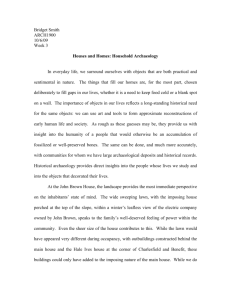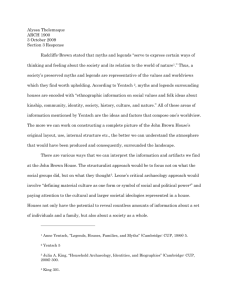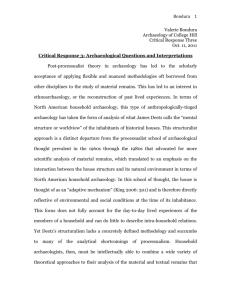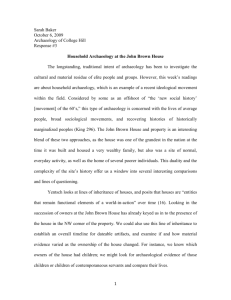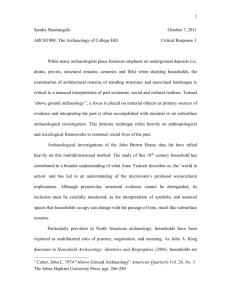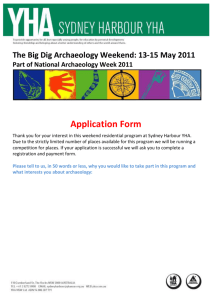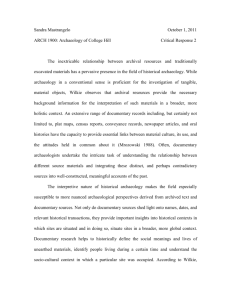JPridham Critical Response 3 10.5.2009
advertisement
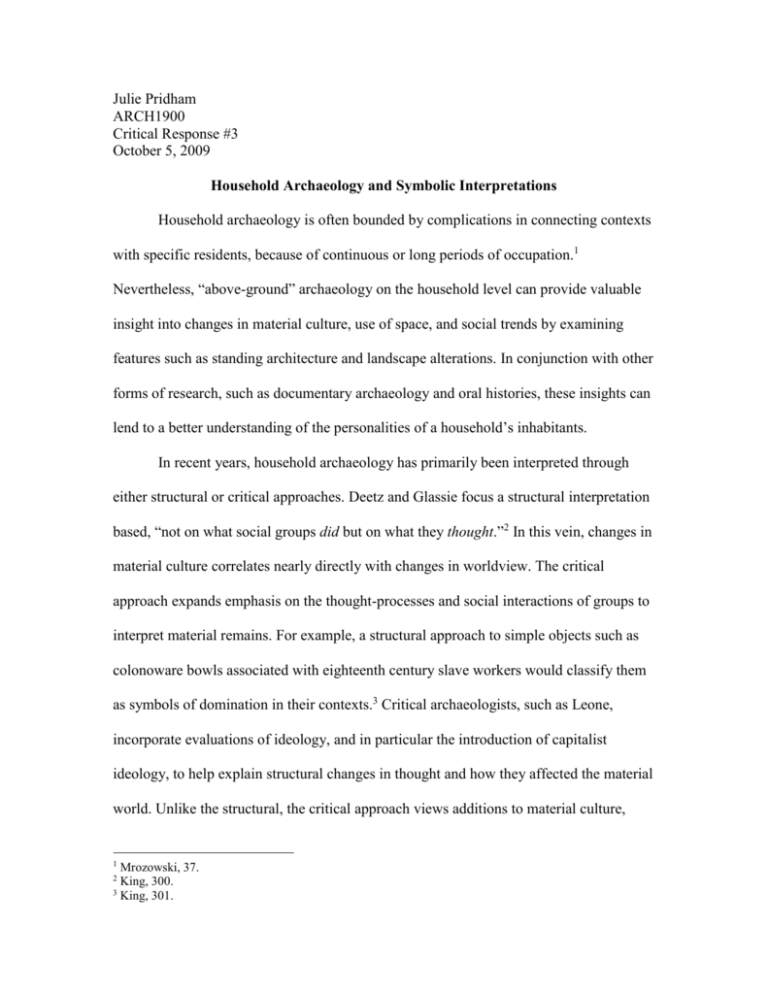
Julie Pridham ARCH1900 Critical Response #3 October 5, 2009 Household Archaeology and Symbolic Interpretations Household archaeology is often bounded by complications in connecting contexts with specific residents, because of continuous or long periods of occupation.1 Nevertheless, “above-ground” archaeology on the household level can provide valuable insight into changes in material culture, use of space, and social trends by examining features such as standing architecture and landscape alterations. In conjunction with other forms of research, such as documentary archaeology and oral histories, these insights can lend to a better understanding of the personalities of a household’s inhabitants. In recent years, household archaeology has primarily been interpreted through either structural or critical approaches. Deetz and Glassie focus a structural interpretation based, “not on what social groups did but on what they thought.”2 In this vein, changes in material culture correlates nearly directly with changes in worldview. The critical approach expands emphasis on the thought-processes and social interactions of groups to interpret material remains. For example, a structural approach to simple objects such as colonoware bowls associated with eighteenth century slave workers would classify them as symbols of domination in their contexts.3 Critical archaeologists, such as Leone, incorporate evaluations of ideology, and in particular the introduction of capitalist ideology, to help explain structural changes in thought and how they affected the material world. Unlike the structural, the critical approach views additions to material culture, 1 Mrozowski, 37. King, 300. 3 King, 301. 2 such as the appearance of scientific instruments in the early eighteenth century, as the result of ideologies attempting to represent “social relationships as natural.”4 With regard to material remains at the John Brown House, it is difficult to say which approach will be the most accurate way to interpret findings. To be sure, it will be important to consider all groups present on the property, and how they contributed to and used those materials. For example, while examining occurrences of differing pottery types, such as red ware and hand painted porcelain, we should keep in mind who would have been the primary users and who could be responsible for deposition in addition to actual place of deposition. Since we know that the Brown family was involved in the slave trade, but have no specific evidence of slaves living on the property, it is imperative that we do not make assumptions, but allow for educated interpretations which use supplementary sources to relate materials to a greater social context. As Mrozowski points out while discussing ceramics at the Tate and Brown households, such items were “viewed as symbolic capital that played a role in the broader communication of class and social status.”5 Therefore, if we can establish an understanding of the social climate contemporary with material finds, we can make better informed analyses of their relation to those social standards. In addition to material culture, architectural and landscape features can be used to interpret space use and function, particularly as they relate to societal influences and contexts. Leone focuses primarily on the gardens in eighteenth century Annapolis, Maryland to illustrate that with the rise in disparate wealth, those with the most funds 4 5 King, 301-302. Mrozowski, 49. used their homes and gardens to establish a rational social order rooted in nature.6 This social order was inherently shown through the physical organization and strict manipulation of sight lines which enhanced the appearance of houses and gardens. Though we do not have visible gardens remaining at the John Brown House dating to John Brown’s occupation of the property, the architecture of the house provides most of that information. The nearly perfect cube of the original structure, as well as it’s placement on the hill well above the main thoroughfare, certainly established John Brown as a powerful feature of the Providence community. Certain features of the house and grounds, including the extravagant interior staircase and the presence of Persephone and Hades busts above the main gate, would have showcased Brown’s wealth and education to that community. The progression of inhabitants at the John Brown House also indicates the social significance of the property. Yentsch’s article focuses on the legends of houses and families as they represent a type of American mythology. From the Vincent House, Hancock’s Revolution, and the Mowry-Smith Farm, Yentsch draws the conclusion that those houses best remembered are associated with prominent families, who often dominated the political system and amassed large quantities of land.7 Certainly, the Brown family, and in particular John Brown, falls into this category. Unlike the other houses discussed in Yentsch, the John Brown House has enough documentary evidence readily available to dissuade the “legends” that compress house histories. Nevertheless, as several owners of the John Brown property were prominent in their own right, it might be easy to overlook the contributions and experiences of other 6 7 Leone, 250. Yentsch, 10. family members charged with caring for the house and land. In our assessment of the symbolic function of the John Brown House, both with the families that occupied it, and with the greater Providence community, we should take care to look at all of the changes to the property, not just those by John Brown or Marsden Perry. For example, additions to the house made my other Brown family members, can tell us what values were changing in society with the regard to public and private space, as well as the use of space as an indication of wealth, power, and status. We can then relate these overarching trends in architecture and the use of that space to material culture and general social trends evidenced in other resources, such as documents, to better understand the symbolic significance of the site, as well as the experience of its inhabitants. King, Julia A. 2006. Household archaeology, identities, and biographies. In D. Hicks and M. Beaudry, eds., The Cambridge Companion to Historical Archaeoloy. Cambridge: CUP, 293-313. Leone, Mark P. 1988. The Georgian Order as the Order of Merchant Capitalism in Annapolis, Maryland. In M. Leone and P. Potter, Jr., eds, The Recovery of Meaning: Historical Archaeology in the Eastern United States. Smithsonian: Washington, 235-262. Mrozowski, Stephen A. 2006. Shifting the focus: archaeology of the urban household. In The Archaeology of Class in Urban America. Cambridge: CUP, 36-62. Yentsch, Anne. 1988 Legends, houses, families, and myths: relationships between material culture and American ideology. In M. Beaudry, ed. Documentary Archaeology in the New World. CUP: Cambridge, 5-19.
